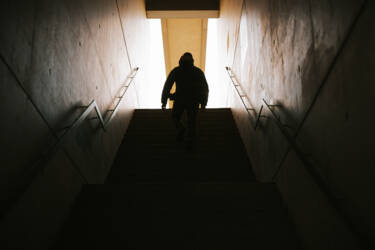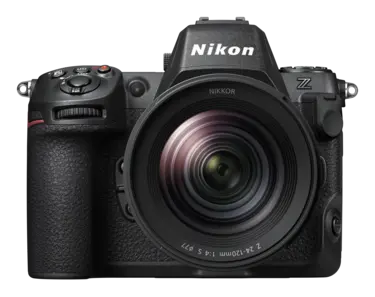Lessons in low light: The benefits of the f/1.4 aperture

Marcello Zerletti captures Berlin in the early morning with the NIKKOR Z 35mm f/1.4
It’s 5.30am and the usual bustle around the Altes Museum, the Neoclassical masterpiece in Berlin’s Museum Island, is silent except for the occasional bird song. Marcello Zerletti, standing alone with his Z8 and NIKKOR Z 35mm f/1.4, pulls his camera up to his eye, looks through the EVF and captures the first of the sun’s rays grazing the museum’s side. Not one to stay in the same spot for more than ten minutes, he walks south. He is without a plan, but on a mission: to test how the NIKKOR Z 35mm f/1.4 performs in low light.
“An hour before sunrise, when the streetlights are still on, I’ll review a scene, wait five minutes for some people to cross or a car to drive through, then take a photo,” explains the Berlin-based Nikon Creator, who’s known for his atmospheric streetscapes. Typically, he pairs his Z8 with the NIKKOR Z 24-70mm f/2.8 S, but this time Nikon magazine sent him the new NIKKOR Z 35mm f/1.4 to try out. His first impressions? “Light, affordable and an excellent lens to walk around with,” he says.

Marcello with the Z8 and NIKKOR Z 35mm f/1.4
Making the switch to prime
The main difference from switching from a lens like the NIKKOR Z 24-70mm f/2.8 S to a NIKKOR Z 35mm f/1.4 is the need to ‘zoom with your feet’. A fixed focal length means you’ve got to place yourself in the right place to frame. “Sometimes, when I’m burnt out or have lost inspiration, I challenge myself to choose one lens and work only with that lens for a week to capture different angles,” adds Marcello. So, how did he get on?


Freedom to frame
“These two buildings (above left) remind me of New York,” Marcello tells Nikon magazine. “It’s quite unusual for Berlin. Originally, the 35mm wasn’t close enough to capture the buildings, so I repositioned, stood in the middle and waited until the two birds started flying – using a shutter speed of 1/400 secs to freeze the birds mid-air. I love that they are flying in the middle.”
Capture darker environments without raising ISO
“The spot outside the Klosterstraße U-Bahn (above right) is very cool – in winter, too. I wanted the person sharp so used 1/400 secs with an aperture of f/1.4. My ISO is 500. With my NIKKOR Z 24-70mm f/2.8 S on the same morning with the same conditions, I’d have to use ISO 1000. The wider aperture makes a big difference.”

Exceptional autofocus
“This is my partner in crime, Patrick Noack. We walked around the government district at 6.30am, while there was nobody around (above). I asked him to walk up the stairs. I was keen to have him super sharp, so switched my shutter speed to 1/640 secs. The autofocus is incredibly fast, even in low light, and always where I needed it to be. For greater flexibility, I always photograph in RAW. That way I could lighten the stairs in post-production.”


Go beyond picture-perfect postcards
“A cathedral in the early morning light, lit by streetlamps, looks so different at midday surrounded by tourists. When it’s dark, it’s always a good idea to find a reflection to add interest. On a particular dry day (above left), the marble reflected the light and Berlin’s TV Tower – it looks like water, right? That’s down to the wide aperture (f/1.4) and slower shutter speed (1/100 secs) – no polarising filter!”
Mix up composition with a wide aperture
“Everyone who takes pictures of cherry blossoms does so in the daytime, always with a bright blue sky (as I did too, in this tried and tested). I love the idea of cherry blossoms in the darkness (as in the above left image). The street is wet with puddles, and I love the reflections and the reflections of the taillights. It was easy to capture with this lens with the f/1.4 aperture and then I made certain parts lighter in post-production.”
No flash? No problem. Film with ease
“I headed to Berlin Cathedral to film the streetlamps against the darkness, before walking to a crowded spot with commuters. I crouched down low to film the sun. I really like the sun star created by the lens in this video. Most of the time I use a filter to take away the star but, in this case, I love it – it frames the video.”


Battle different light sources
“The difficulty with the two images above is the stark contrast in colour. The light of the statue is much colder, more blue and stark white compared to the warmth of the streetlamps and the cathedrals. In the above right image, I walked up to the statue, set my shutter speed to 1/80 secs and angled the camera so the spire and the statue are the same size. The sharp colour keeps the contrast. On the left, I’ve pulled back to show the versatility of the 35mm focal length.”
Read Marcello’s full tried and tested review of the NIKKOR Z 35mm f/1.4 here.
More in low-light
Discover the NIKKOR Z 35mm f/1.4

Unlock greater creativity











